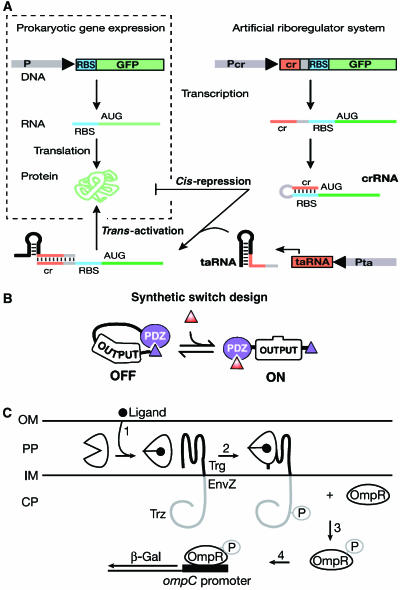Figure 2.
Types of devices. (A) Non-coding RNA device. The transcript of a target gene contains an artificial upstream RNA sequence complementary to its ribosome-binding site (RBS), which forms a stem–loop structure in the RBS region, inhibiting translation of the target gene by cis-repression. When a transcribed non-coding RNA binds specifically to the artificial cis-RNA sequence, this prevents formation of the stem–loop structure in the RBS region, permitting the trans-activation of gene expression (Figure 2A reprinted (excerpted) with permission from Isaacs FJ et al, Nat Biotechnol 22: 841–847. Copyright 2004 NPG). (B) Allosteric protein. The gate is in an ‘off' state when an output domain of an engineered protein binds to a tethered allosteric regulatory domain to form an autoinhibited complex. An input ligand can bind to the regulatory domain, relieving the inhibition to liberate the binding or active site of the output domain, switching the gate to the ‘on' state (Figure 2B reprinted (excerpted) with permission from, Figure 1B, Dueber JE et al, Science 301: 1904. Copyright 2003 AAAS). (C) Engineered receptor for trinitrotoluene (TNT), L-lactate, or serotonin. Redesigned E. coli periplasmic EnvZ receptors participated in His-to-Asp two-component signaling through autophosphorylation and subsequent transfer of the phosphate to the regulatory response element OmpR (Figure 2C reprinted (excerpted) with permission from Looger LL et al, Nature 423: 185–190. Copyright 2003 NPG).

